The approach to Laxmi Niwas Palace down the long driveway evoked an Indian Downton Abbey episode of my imagination. The pink stone from Dulmera was the perfect medium with which to create this Indo-Saracenic beauty, and its domed chhatris and harem windows beckoned in the sunlight. Maharaja Ganga Singh commissioned Laxmi Niwas Palace to be built as his royal residence as the world ushered in the 20th century and it wasn’t until the beginning of the 21st century that it was converted into an historic hotel.
Staff flooded the expansive front lawn in their hurried efforts to set up for an event – not for an aristocratic garden party, but rather an extravagant and lavish contemporary wedding. In addition to the traditional catering and decorative embellishments, cables were strewn spaghetti-like across lawns, waiting to be rigged for lights and sound on a scale similar to a rock concert. The coming weekend promised to be huge, but luckily we would be gone before the festivities took off.
It is easy to imagine one is visiting the Maharaja, a welcome commoner amongst royalty and dignitaries from around the world, as we alighted from our car. We were greeted by an immaculately uniformed valet who ushered us into the luxurious foyer, which, while modest in size, was the epitome of taste and class in its décor. Nestled in a velvety cushioned chair, the reception staff came to us to complete our check in process, as another white gloved pair of hands provided refreshments. None of this standing at a desk, waiting after a long drive through Rajasthan.
The level of service at this regal hotel is beyond compare. The fact that we were staying in the Heritage Suite must have labelled us as VIPs, and ALL staff treated us as such. One distinct difference in the individual staff members of this exclusive hotel is their bearing and their pride in what they do. In other 5 star hotels where I have stayed, if you happen upon housekeeping staff in a corridor, they will try and make themselves as inconspicuous as possible. At Laxmi Niwas Palace, they stand tall, meet your gaze, smile and greet you with a warm salutation, whether they are the janitor or executive staff.
Our Heritage Suite was on the ground floor on the edge of the main courtyard where the al fresco seating of the restaurant is located. When Vikash Singh Tanwar escorted us to our room after check in, I asked about making a reservation for dinner, he replied, “The best table has been reserved for you, ma’am, you are VIPs.” Impressive!
The suite itself was easily the largest and most grandiose hotel room we have ever stayed in. The royal blue, white and gold of the painted walls were in their naturally aged state from when they were painted in the 1900s. While this creates an authentic atmosphere, we were told that some guests are disappointed with the affect of age upon the room, feeling that it should be regularly painted. The history of this is lost on many, and they lack appreciation of what it means to stay in such a suite. Admittedly, it is easy to overlook an aged patch on the wall when it is near the 7m high ceiling. Besides, the eye is too often drawn to the brightness of the gold paint trim throughout and sparkle of the chandeliers!
It only took a moment for my eye to be drawn to the welcome treats awaiting us on the coffee table in the sitting area – a three-tiered plate stand of a tasty selection of biscuits, nuts, dried and fresh fruit, plus two jars, one with bhuja mix, the other with some undisclosed wheaty snack covered in pleasantly spicy dust.
The majesty of the palace was not limited to our suite. Dinesh led us through several spaces that opened onto the main courtyard for us to get a sense of the history of Laxmi Niwas. He opened the locked Conference Room and stood back to watch our reaction. The room was delicately decorated in 45kg of gold paint, which is why it is kept locked, otherwise ‘looters’ would gouge out chunks of the wall to steal the gold. When the hotel was a palace, this was the Maharaja’s official meeting room. Time has not dulled its beauty; it certainly continues to awe and amaze its visitors.
The billiard room is clearly a space where the Maharaja enjoyed spending time, and it is not a room for the faint-hearted animal lover. One guide book has stated that there are more tigers on the walls of this palace than are left alive in the wild. Not too much of an exaggeration, I think! And it’s not just the heads of tigers adorning these walls, it’s all manner of African animals as well. But even as a vegetarian I am able to view these trophies through the lens of history, with an appreciation for context.
The bar is filled with dark wood, both panelled and furnished, and more trophies – rhino and gigantic water buffalo mixed in amongst the tigers. Bottle green drapes flank the doors at either end of the room – one leading to the courtyard, the other to the pool. Plush padding on the bar stools, baby grand piano and ready bar tender all fuel the imaginations of a bygone era where the men withdrew to smoke their cigars and boast about their exploits.
We exited through the far door of the bar to the pool area. I predict that this infinity edged, deep blue beacon of still water would be crowded of an afternoon in summer, but alas, we were visiting in winter, and it was of no temperature to take a dip. But the location, nestled in a side-terraced secluded spot with views of the gardens, would make the perfect place for some gentle afternoon rays, sipping on an aperitif and thinking about what to wear to dinner.
It didn’t take long in our solo explorations for us to find the rooftop terraces. The maze of staircases in the palace leads to different areas of the roof. It is a lovely spot to enjoy the sunset. And romantic dinners can be catered for on the rooftop in secluded pavilions, while terraces on other levels cater to small parties.
Each of our experiences at the restaurant was world class, thanks to the talents of Executive Chef Kisan Singh Shekawat. We enjoyed a delightfully relaxing late lunch the afternoon of our arrival with very few people remaining at their tables. We chose a Mughlai dish of subz jalfarezi (mixed vegetables, green chillies, onion, ginger, tomato gravy), a regional dish of daal panchmel (5 types of lentils simmered together, tempered with cumin, onions and tomatoes) and a garlic naan. Splurged on a bottle of French bubbles, too (Blanc Foussy Brut, Touraine, France). Our waiter, Dinesh Singh (who was also our guide in the Conference Room), took excellent care of us, with his refined balance of friendly and efficient service, yet always respectful and competent.
Our dinner was equally superb with a Punjabi dish of Baingan ka bhatra (char-grilled aubergine cooked with onion, green chillies and tomatoes), followed by a regional dish of Ker Sangri (dessert berries and dried beans cooked together), and pudina parantha (mint flavoured bread cooked in tandoor) and a plain tandoori roti. We chose a Kingfisher beer and a Laxmi Niwas Mai Tai to accompany this perfectly cooked and presented food. Falu Roy was our waiter for both of our dinners in the restaurant, and his perfect memory for our preferences in terms of drinks, sides and condiments was noted and appreciated. We also valued his suggestions when making decisions about our choice of dishes.
The atmospheric setting of dinner around the water feature and garden in the central courtyard is further enhanced by the nightly cultural performances. These vary each night in style and form, from traditional puppet show to dancing and musicians, which offers wonderful diversity when staying more than one night. We had four male musicians and a female dancer to entertain us with music and dancing from the region. All of the performances, as you would expect, were of a quality worthy of the palace.
Of a morning there was the very soft and gentle sounds of a live flute player in the courtyard from about 7:15am onwards. This was the most surprising and wonderful way to drift into consciousness; one of the nicest accompaniments to rising I’ve ever experienced. It was meant as a bonus to the breakfast restaurant rituals, but as our room opened onto the main courtyard, it was like our own personal morning gift!
As to be expected at such a unique, world class and extraordinary hotel, each component of our stay at Laxmi Niwas Palace was beyond all expectations. But what truly made this experience unforgettable was every single staff member we had the pleasure of meeting. They are not all locals, but they are the best. Besides those already mentioned, we had the assistance of Ashu Singh Rathore (Assistant Day Manager, who helped us with exchanging money, as well as advice on local attractions) and Deepak Singh Rathore, who offered suggestions on restaurants in Bikaner. I particularly enjoyed our conversation with Executive Chef Kisan Singh Shekawat after dinner one evening, chatting about regional specialties and his joy of cooking.
The city of Bikaner is a fascinating cultural and architectural gem in Rajasthan, and the Laxmi Niwas Palace is the perfect base from which to explore it…especially if you are in search of one of India’s most distinctive and luxurious hotels for an outstanding pampering during your visit.
Accommodation: Laxmi Niwas Palace
Tour Company: Intense India Tours
Click on any image below to view as gallery
- Night time pool reflection, Laxmi Niwas Palace, Bikaner
- Pool at night, Laxmi Niwas Palace, Bikaner
- Courtyard colonnade at night, Laxmi Niwas Palace, Bikaner
- Rooftop pavilion at night, Laxmi Niwas Palace, Bikaner
- The view of the courtyard from the rooftop of Laxmi Niwas Palace, Bikaner
- Statue of the Maharaja, Laxmi Niwas Palace, Bikaner
- Courtyard colonnade of Laxmi Niwas Palace, Bikaner
- Rooftop seating at Laxmi Niwas Palace, Bikaner
- The rooftop pavilions at Laxmi Niwas Palace, Bikaner
- The pool at Laxmi Niwas Palace, Bikaner
- Pigeons at the pool at Laxmi Niwas Palace, Bikaner
- The bar of Laxmi Niwas Palace, Bikaner
- Tiger skins in the billiard room of Laxmi Niwas Palace, Bikaner
- The billiard room of Laxmi Niwas Palace, Bikaner
- Fireplace in the golden Conference Room in Laxmi Niwas Palace, Bikaner
- The arches in the Conference Room of Laxmi Niwas Palace, Bikaner
- Golden Conference Room in Laxmi Niwas Palace, Bikaner
- Carving detail at Laxmi Niwas Palace, Bikaner
- Sitting room area of the Heritage Suite, Laxmi Niwas Palace, Bikaner
- Heritage Suite at the Laxmi Niwas Palace, Bikaner
- Magnificent four poster bed in the Heritage Suite, Laxmi Niwas Palace, Bikaner
- Laxmi Niwas Palace, Bikaner, Rajasthan

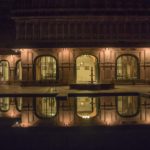
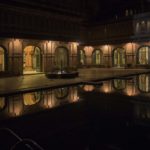
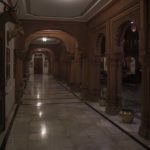
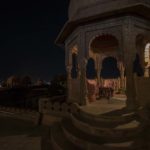
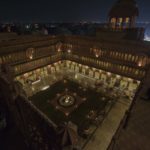

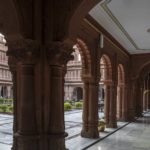
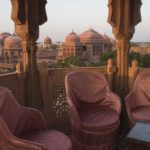
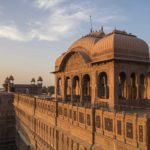
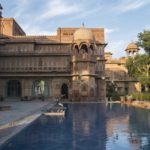

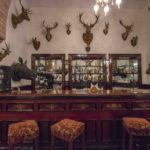

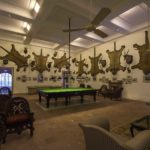

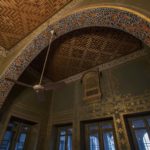
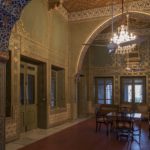

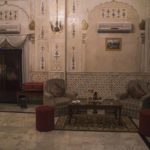
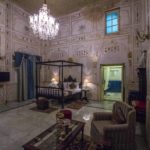
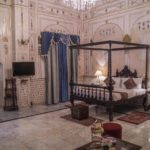
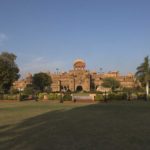
Pingback: Bikaner, Rajasthan – bontaks travels